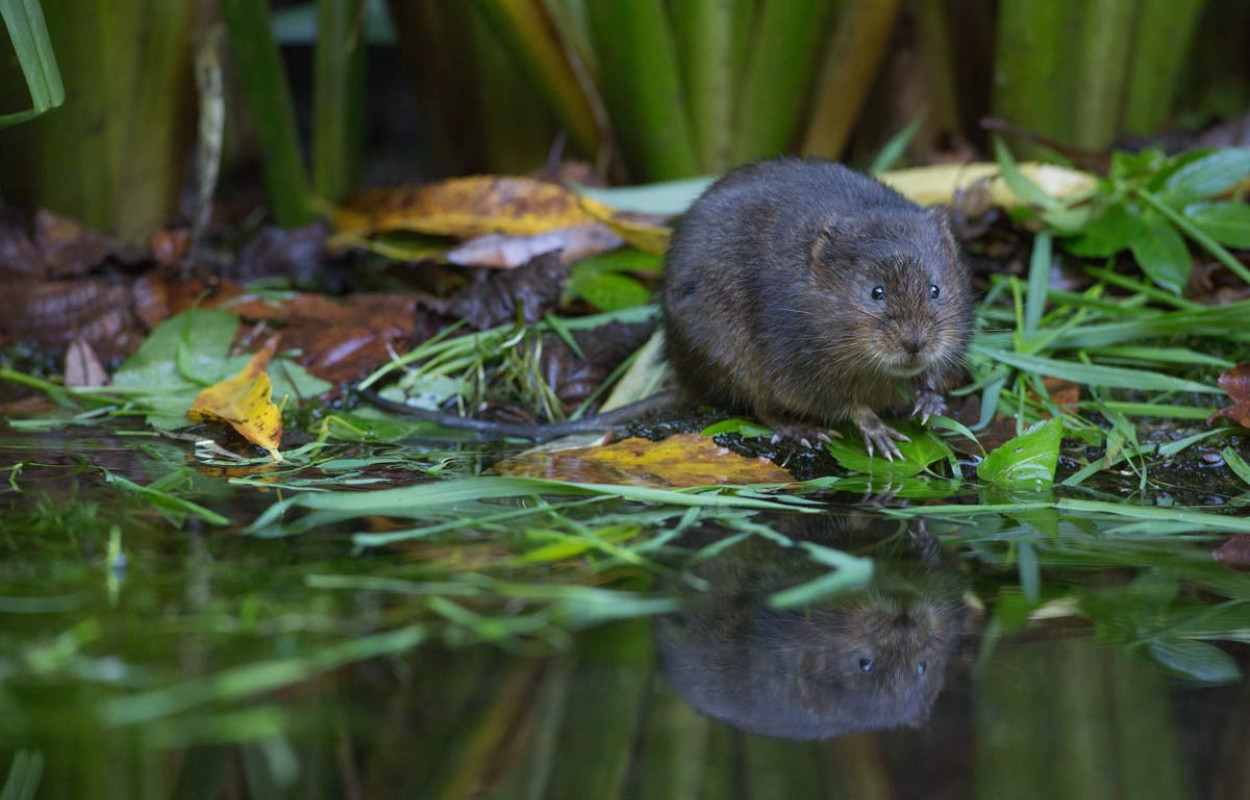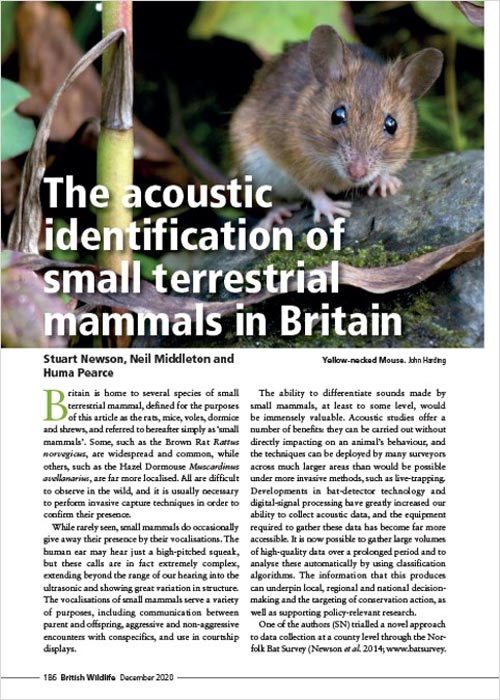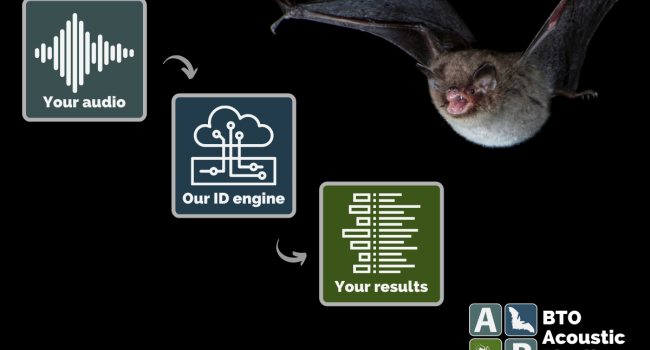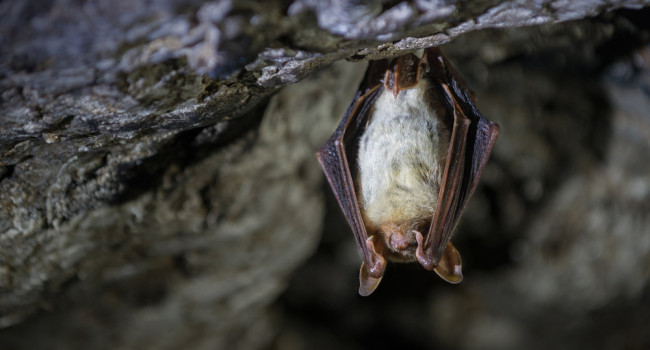The acoustic identification of small terrestrial mammals in Britain

Author(s): Newson, S.E., Middleton, N., & Pearce, H.
Published: December 2020 Pages: 10pp
Journal: British Wildlife Volume: 32
View the articleBritain is home to several species of small mammals, which include rats, mice, voles, dormice and shrews. All of these are difficult to observe in the wild, and it is usually necessary to capture them to confirm their presence. By describing the vocal repertoire of small mammals in Britain, research published in British Wildlife by a team led by the BTO provides new possibilities for sound identification to be used as a non-invasive survey method.
This has considerable potential to help conservation efforts by providing a cost-effective and robust method for detecting the presence of small mammals (e.g. Hazel Dormice in woodland, Brown Rats on seabird islands), which could be followed up with more intensive survey work if needed.
It is likely that large volumes of data on small mammals are already being collected incidentally, but probably unknowingly, across Britain by bat workers using bat detectors. To maximise the value of bat surveys, the BTO Acoustic Pipeline improves on the sound identification of bats, whilst also providing results for small mammals and other species groups.
For the full article, see British Wildlife Volume 32, Number 3, December 2020.
Download a zipped file containing original .wav audio clips (ZIP, 91MB) accompanying the publication.
Sample audio clips
Listen to sample audio clips of species below, processed to be audible:
Wood mouse
001 A sylvaticus typical recording 30-40kHz
002 A sylvaticus some calls exceed 65kHz
003 A sylvaticus calls exceed 65kHz
004 A sylvaticus inverted v shape calls 60-65kHz
005 A sylvaticus calls below 30kHz
Yellow-necked mouse
006 A flavicollis calls between 45-59kHz
007 A flavicollis typical recording calls 30-40kHz
008 A flavicollis u shaped call 30-45kHz
009 A flavicollis typical recording calls 30-40kHz
010 A flavicollis higher frequency calls 45-59kHz
House mouse
015 M musculus including high frequency calls
016 M musculus variation high frequency calls
017 M musculus low frequency calls
018 M musculus typical recording
Harvest mouse
019 M minutus typical recording
020 M minutus typical recording variation
021 M minutus typical recording variation
022 M minutus typical recording variation
023 M minutus inverted u shape calls
024 M minutus inverted u shape calls
Brown rat
025 R norvegicus CF calls 22kHz
026 R norvegicus typical calls 45kHz
027 R norvegicus less typical CF calls 30kHz
028 R norvegicus less typical calls 60kHz
029 R norvegicus less typical abrupt frequency changes
030 R norvegicus less typical short calls 22kHz
Black rat
031 R rattus typical recording CF calls 23kHz
032 R rattus less typical call 30kHz
033 R rattus short calls 30kHz
034 R rattus typical calls of 45kHz
035 R rattus less typical CD calls
036 R rattus lower frequency calls
Hazel dormouse
037 M avellanarius call sloping upwards 30kHz
038 M avellanarius typical recording call sloping upwards
039 M avellanarius typical recording variation
040 M avellanarius higher frequency example call sloping up
041 M avellanarius inverted v shaped calls
042 M avellanarius low frequency call sloping up
043 M avellanarius complex call sequence
044 M avellanarius male advertisement calls
045 M avellanarius complex calls variation
Water vole
046 A amphibius typical recording
047 A amphibius similar to R rattus
048 A amphibius less typical with abrupt frequency change
049 A amphibius typical recording with step change
050 A amphibius complex sequence
051 A amphibius less typical call no step
052 A amphibius higher frequency calls
053 A amphibius higher frequency calls with step
Field vole
054 M agrestis typical recording below 20kHz
055 M agrestis calls at 20kHz
056 M agrestis high frequency call
057 M agrestis calls between 30-40kHz
Bank vole
011 M glareolus typical recording calls 30-40kHz
012 M glareolus call_variation 1
013 M glareolus call variation 2
014 M glareolus call variation 3
Common shrew
058 S araneus less typical calls sloping down
059 S araneus typical calls five harmonics
060 S araneus typical recording consistent calls
061 S araneus less typical example variable calls
Pygmy shrew
062 S minutus typical recording sloping calls multiple harmonics
063 S minutus typical recording sloping calls complex start
064 S minutus typical recording sloping calls multiple harmonics
065 S minutus complex call otherwise typical recording
Water shrew
066 N fodiens typical recording
067 N fodiens typical recording
068 N fodiens typical recording strongest harmonic ending 10kHz
069 N fodiens typical recording
Notes
Appendix to publication
Thanks to the co-authors -
- Neil Middleton (neil.middleton@batability.co.uk) is the owner of BatAbility Courses & Tuition, an organisation that focuses on the development of people within the ecology sector.
- Huma Pearce (huma@mostlybats.org) is a freelance ecologist specialising in mammals and urban ecology.
The work on this article was funded by JNCC and the Esmée Fairbairn Foundation.








Share this page